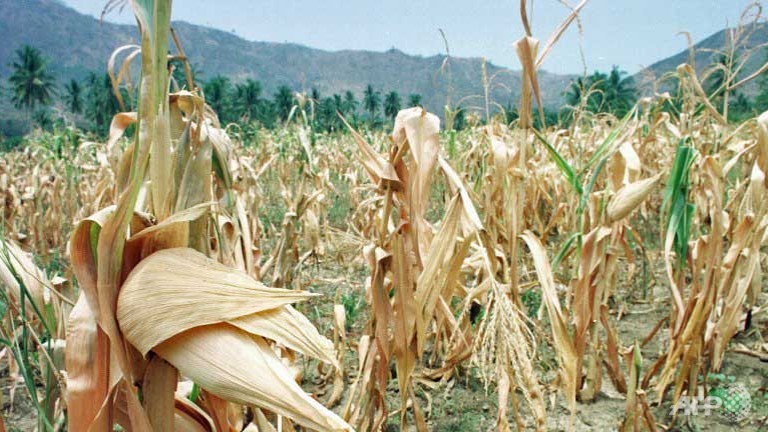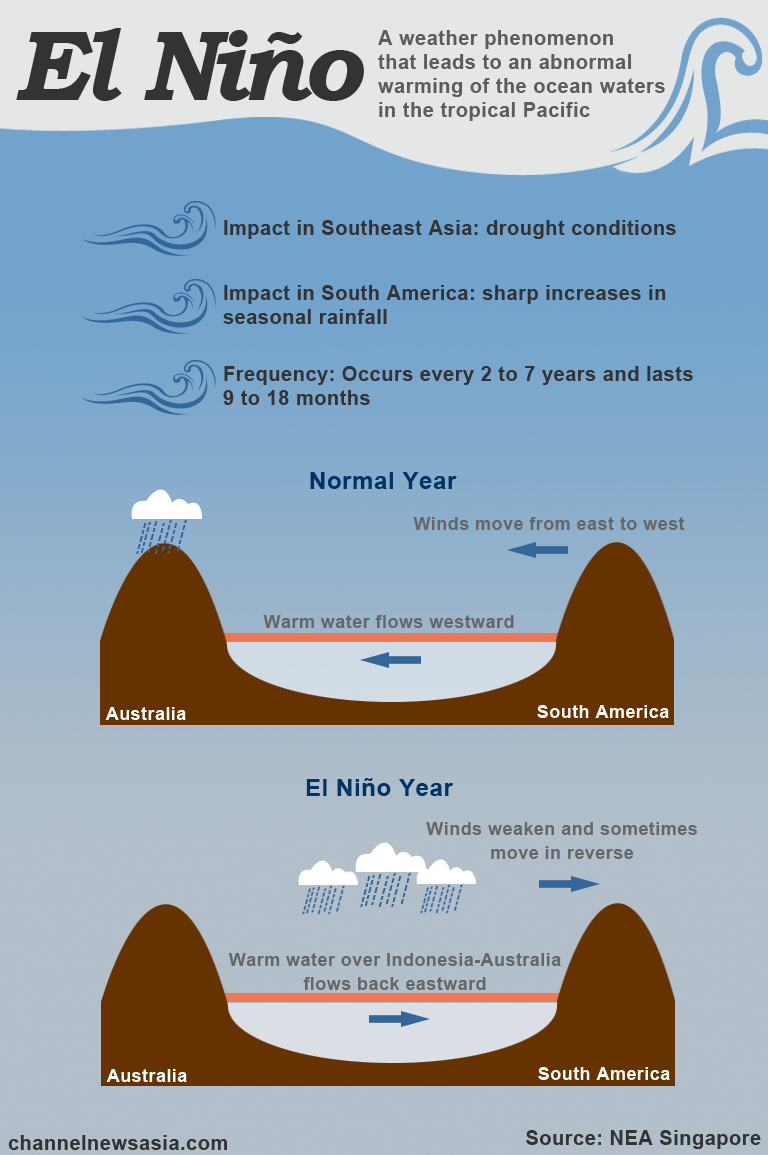UN warns El Nino likely by end of year
Update: 26-06-2014 | 00:00:00
The "El Nino" phenomenon, which sparks climate extremes around the globe, is likely to take hold in the Pacific Ocean by the end of the year and could even do so within weeks, the UN said on Thursday.
There was an 80 percent likelihood that El Nino could start between October and November and 60 percent that it would do so between now and end of August, said the UN's weather agency, the World Meterological Organization.
 File photo of corns wilting on a farm in southern Philippines following severe drought caused by the El Nino weather phenomenon. (AFP/ROMEO GACAD)
The El Nino phenomenon -- which can lead to extremes including droughts and heavy rainfall across the globe -- occurs every two to seven years, when the prevailing trade winds that circulate over surface waters in the tropical Pacific start to weaken.
The phenomenon, which last occurred between June 2009 and May 2010, can play havoc for farmers and global agricultural markets.
It leaves countries like India, Indonesia and Australia drier, increasing chances of wildfires and lower crop production, while leading to heavier rainfall in the eastern Pacific and South American nations, raising the spectre of floods and landslides.
"El Nino leads to extreme events and has a pronounced warming effect," said WMO chief Michel Jarraud.
El Nino drags precipitation across the Pacific, leaving countries including India and Indonesia drier.
India's monsoon rains have already arrived five days later than normal, and the prospect of a weak rainy season has raised fears of lower crop production and rising food prices.
File photo of corns wilting on a farm in southern Philippines following severe drought caused by the El Nino weather phenomenon. (AFP/ROMEO GACAD)
The El Nino phenomenon -- which can lead to extremes including droughts and heavy rainfall across the globe -- occurs every two to seven years, when the prevailing trade winds that circulate over surface waters in the tropical Pacific start to weaken.
The phenomenon, which last occurred between June 2009 and May 2010, can play havoc for farmers and global agricultural markets.
It leaves countries like India, Indonesia and Australia drier, increasing chances of wildfires and lower crop production, while leading to heavier rainfall in the eastern Pacific and South American nations, raising the spectre of floods and landslides.
"El Nino leads to extreme events and has a pronounced warming effect," said WMO chief Michel Jarraud.
El Nino drags precipitation across the Pacific, leaving countries including India and Indonesia drier.
India's monsoon rains have already arrived five days later than normal, and the prospect of a weak rainy season has raised fears of lower crop production and rising food prices.
 In Indonesia, there are concerns that dry conditions could fan wildfires caused by slash-and-burn techniques used to clear land quickly and cheaply.
Fires on Indonesia's western Sumatra island last June already caused the worst haze in Southeast Asia for more than a decade, affecting daily life for millions and sparking a heated diplomatic row with neighbouring Singapore and Malaysia.
Australia also tends to be drier during an El Nino, increasing the risk of bush fires.
El Nino-year winters are generally drier in the north of the United States and Europe.
El Nino also causes heavier-than-normal rainfall in the eastern Pacific and South America -- raising the spectre of floods and landslides, as well as shifting nutrient-rich ocean currents that lure fish.
In the past, that has battered local fishing industries and caused diplomatic battles over shifting fishing zones.
The southwest United States and southern Africa, meanwhile, tend to be drier, while east Africa faces heavy rainfall.
The name El Nino is believed to have been coined in the 19th century after Peruvian fisherman observed it around Christmas -- the word is Spanish for "boy", in reference to the infant Jesus Christ.
La Nina, the word for "girl", was devised later to label the reverse phenomenon, which is characterised by unusually cool ocean surface temperatures in the central and eastern tropical Pacific, the last of which ended in April 2012.
Both are significant markers of global climate fluctuations.
"Our understanding of El Nino and La Nina has increased dramatically in recent years and this knowledge has enabled us to develop very successful climate services for society," said Jarraud.
"Advance warning has given governments around the world time to make contingency plans for the impact of this year's expected El Nino on the agriculture, water management, health and other climate-sensitive sectors," he said.
"We remain vulnerable to this force of nature but we can protect ourselves by being better prepared," he added.
The two climate patterns are watched carefully by scientists who say that, while they are not caused by climate change, rising ocean temperatures stoked by global warming may affect their intensity and frequency.
"It is too early to assess the precise impact on global temperatures in 2014, but we expect the long-term warming trend to continue as a result of rising greenhouse gas concentrations," noted Jarraud.
- AFP/ir
In Indonesia, there are concerns that dry conditions could fan wildfires caused by slash-and-burn techniques used to clear land quickly and cheaply.
Fires on Indonesia's western Sumatra island last June already caused the worst haze in Southeast Asia for more than a decade, affecting daily life for millions and sparking a heated diplomatic row with neighbouring Singapore and Malaysia.
Australia also tends to be drier during an El Nino, increasing the risk of bush fires.
El Nino-year winters are generally drier in the north of the United States and Europe.
El Nino also causes heavier-than-normal rainfall in the eastern Pacific and South America -- raising the spectre of floods and landslides, as well as shifting nutrient-rich ocean currents that lure fish.
In the past, that has battered local fishing industries and caused diplomatic battles over shifting fishing zones.
The southwest United States and southern Africa, meanwhile, tend to be drier, while east Africa faces heavy rainfall.
The name El Nino is believed to have been coined in the 19th century after Peruvian fisherman observed it around Christmas -- the word is Spanish for "boy", in reference to the infant Jesus Christ.
La Nina, the word for "girl", was devised later to label the reverse phenomenon, which is characterised by unusually cool ocean surface temperatures in the central and eastern tropical Pacific, the last of which ended in April 2012.
Both are significant markers of global climate fluctuations.
"Our understanding of El Nino and La Nina has increased dramatically in recent years and this knowledge has enabled us to develop very successful climate services for society," said Jarraud.
"Advance warning has given governments around the world time to make contingency plans for the impact of this year's expected El Nino on the agriculture, water management, health and other climate-sensitive sectors," he said.
"We remain vulnerable to this force of nature but we can protect ourselves by being better prepared," he added.
The two climate patterns are watched carefully by scientists who say that, while they are not caused by climate change, rising ocean temperatures stoked by global warming may affect their intensity and frequency.
"It is too early to assess the precise impact on global temperatures in 2014, but we expect the long-term warming trend to continue as a result of rising greenhouse gas concentrations," noted Jarraud.
- AFP/ir
 File photo of corns wilting on a farm in southern Philippines following severe drought caused by the El Nino weather phenomenon. (AFP/ROMEO GACAD)
The El Nino phenomenon -- which can lead to extremes including droughts and heavy rainfall across the globe -- occurs every two to seven years, when the prevailing trade winds that circulate over surface waters in the tropical Pacific start to weaken.
The phenomenon, which last occurred between June 2009 and May 2010, can play havoc for farmers and global agricultural markets.
It leaves countries like India, Indonesia and Australia drier, increasing chances of wildfires and lower crop production, while leading to heavier rainfall in the eastern Pacific and South American nations, raising the spectre of floods and landslides.
"El Nino leads to extreme events and has a pronounced warming effect," said WMO chief Michel Jarraud.
El Nino drags precipitation across the Pacific, leaving countries including India and Indonesia drier.
India's monsoon rains have already arrived five days later than normal, and the prospect of a weak rainy season has raised fears of lower crop production and rising food prices.
File photo of corns wilting on a farm in southern Philippines following severe drought caused by the El Nino weather phenomenon. (AFP/ROMEO GACAD)
The El Nino phenomenon -- which can lead to extremes including droughts and heavy rainfall across the globe -- occurs every two to seven years, when the prevailing trade winds that circulate over surface waters in the tropical Pacific start to weaken.
The phenomenon, which last occurred between June 2009 and May 2010, can play havoc for farmers and global agricultural markets.
It leaves countries like India, Indonesia and Australia drier, increasing chances of wildfires and lower crop production, while leading to heavier rainfall in the eastern Pacific and South American nations, raising the spectre of floods and landslides.
"El Nino leads to extreme events and has a pronounced warming effect," said WMO chief Michel Jarraud.
El Nino drags precipitation across the Pacific, leaving countries including India and Indonesia drier.
India's monsoon rains have already arrived five days later than normal, and the prospect of a weak rainy season has raised fears of lower crop production and rising food prices.
 In Indonesia, there are concerns that dry conditions could fan wildfires caused by slash-and-burn techniques used to clear land quickly and cheaply.
Fires on Indonesia's western Sumatra island last June already caused the worst haze in Southeast Asia for more than a decade, affecting daily life for millions and sparking a heated diplomatic row with neighbouring Singapore and Malaysia.
Australia also tends to be drier during an El Nino, increasing the risk of bush fires.
El Nino-year winters are generally drier in the north of the United States and Europe.
El Nino also causes heavier-than-normal rainfall in the eastern Pacific and South America -- raising the spectre of floods and landslides, as well as shifting nutrient-rich ocean currents that lure fish.
In the past, that has battered local fishing industries and caused diplomatic battles over shifting fishing zones.
The southwest United States and southern Africa, meanwhile, tend to be drier, while east Africa faces heavy rainfall.
The name El Nino is believed to have been coined in the 19th century after Peruvian fisherman observed it around Christmas -- the word is Spanish for "boy", in reference to the infant Jesus Christ.
La Nina, the word for "girl", was devised later to label the reverse phenomenon, which is characterised by unusually cool ocean surface temperatures in the central and eastern tropical Pacific, the last of which ended in April 2012.
Both are significant markers of global climate fluctuations.
"Our understanding of El Nino and La Nina has increased dramatically in recent years and this knowledge has enabled us to develop very successful climate services for society," said Jarraud.
"Advance warning has given governments around the world time to make contingency plans for the impact of this year's expected El Nino on the agriculture, water management, health and other climate-sensitive sectors," he said.
"We remain vulnerable to this force of nature but we can protect ourselves by being better prepared," he added.
The two climate patterns are watched carefully by scientists who say that, while they are not caused by climate change, rising ocean temperatures stoked by global warming may affect their intensity and frequency.
"It is too early to assess the precise impact on global temperatures in 2014, but we expect the long-term warming trend to continue as a result of rising greenhouse gas concentrations," noted Jarraud.
- AFP/ir
In Indonesia, there are concerns that dry conditions could fan wildfires caused by slash-and-burn techniques used to clear land quickly and cheaply.
Fires on Indonesia's western Sumatra island last June already caused the worst haze in Southeast Asia for more than a decade, affecting daily life for millions and sparking a heated diplomatic row with neighbouring Singapore and Malaysia.
Australia also tends to be drier during an El Nino, increasing the risk of bush fires.
El Nino-year winters are generally drier in the north of the United States and Europe.
El Nino also causes heavier-than-normal rainfall in the eastern Pacific and South America -- raising the spectre of floods and landslides, as well as shifting nutrient-rich ocean currents that lure fish.
In the past, that has battered local fishing industries and caused diplomatic battles over shifting fishing zones.
The southwest United States and southern Africa, meanwhile, tend to be drier, while east Africa faces heavy rainfall.
The name El Nino is believed to have been coined in the 19th century after Peruvian fisherman observed it around Christmas -- the word is Spanish for "boy", in reference to the infant Jesus Christ.
La Nina, the word for "girl", was devised later to label the reverse phenomenon, which is characterised by unusually cool ocean surface temperatures in the central and eastern tropical Pacific, the last of which ended in April 2012.
Both are significant markers of global climate fluctuations.
"Our understanding of El Nino and La Nina has increased dramatically in recent years and this knowledge has enabled us to develop very successful climate services for society," said Jarraud.
"Advance warning has given governments around the world time to make contingency plans for the impact of this year's expected El Nino on the agriculture, water management, health and other climate-sensitive sectors," he said.
"We remain vulnerable to this force of nature but we can protect ourselves by being better prepared," he added.
The two climate patterns are watched carefully by scientists who say that, while they are not caused by climate change, rising ocean temperatures stoked by global warming may affect their intensity and frequency.
"It is too early to assess the precise impact on global temperatures in 2014, but we expect the long-term warming trend to continue as a result of rising greenhouse gas concentrations," noted Jarraud.
- AFP/ir
 Seminar seeks ways to boost ASEAN - Latin America connectivity
Seminar seeks ways to boost ASEAN - Latin America connectivity
 Indonesia seeks India's help in health education
Indonesia seeks India's help in health education
 Indonesia named world's most generous country in 2024
Indonesia named world's most generous country in 2024
 Philippines: Over-4m-high floodwaters make thousands of houses submerged
Philippines: Over-4m-high floodwaters make thousands of houses submerged
 Singapore’s public sector records carbon reduction in 2023
Singapore’s public sector records carbon reduction in 2023
 Pressure facing the EU on its growth track
Pressure facing the EU on its growth track
 Efforts boosted to combat transnational organised crime
Efforts boosted to combat transnational organised crime
 Nearly 200 terror suspects arrested in Indonesia in two years
Nearly 200 terror suspects arrested in Indonesia in two years
 Vietravel launches tourism joint venture in India
Vietravel launches tourism joint venture in India
 Vietnam willing to enhance int'l cooperation in transnational crime combat
Vietnam willing to enhance int'l cooperation in transnational crime combat



